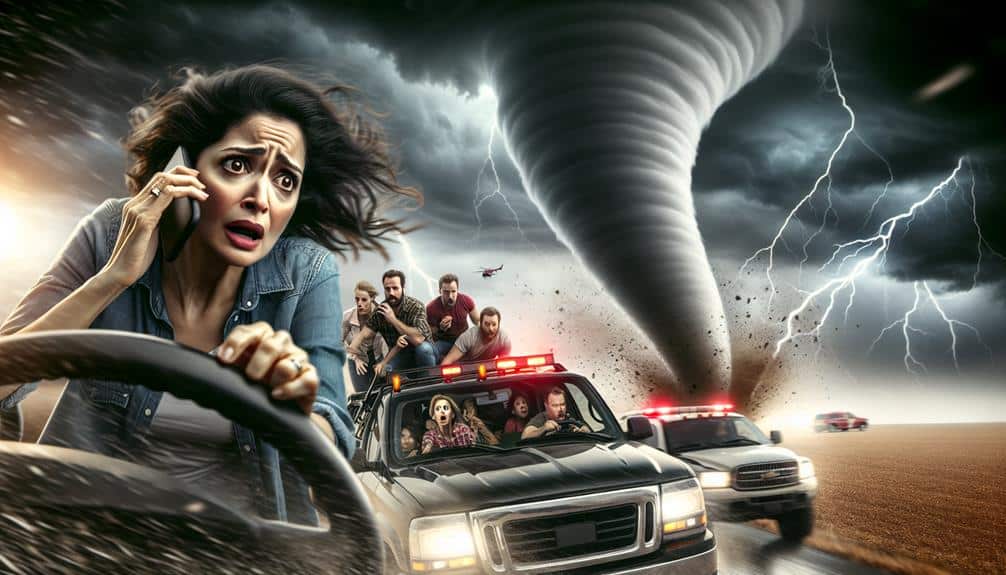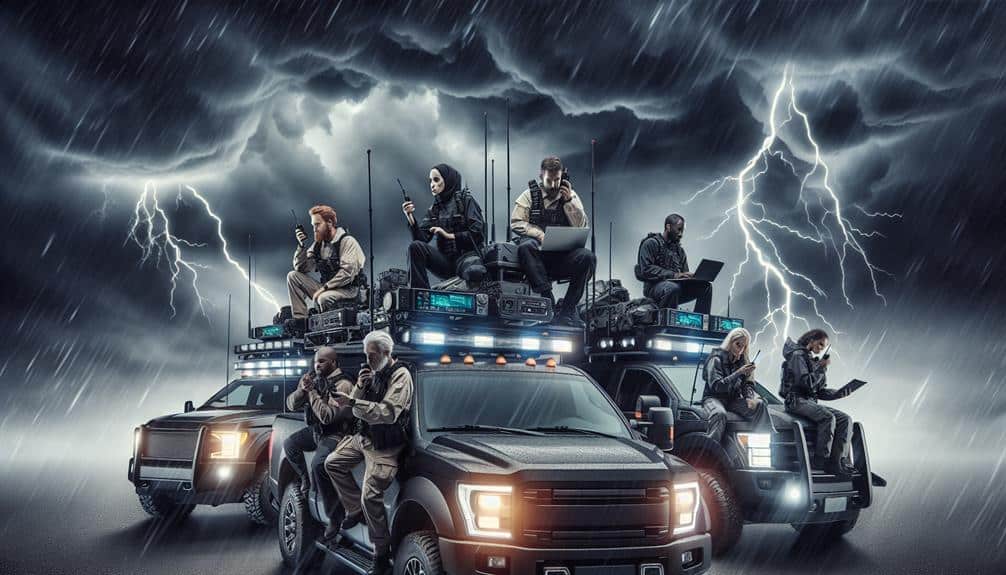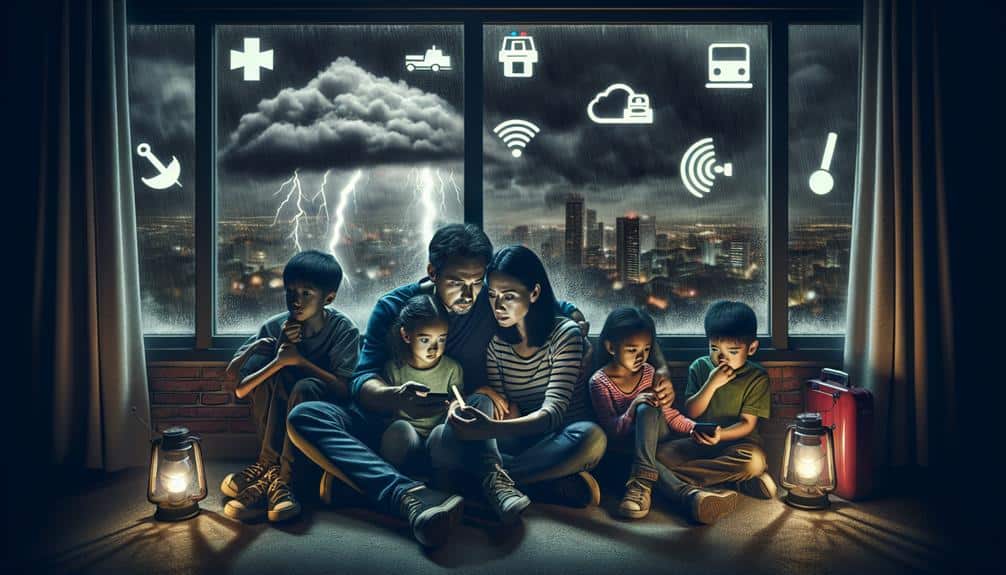To guarantee effective storm emergency communication, we first need to establish dependable channels, utilizing various methods like mobile networks, radios, and internet-based services. Next, we should use clear and concise language, avoiding specialized terminology to ensure widespread understanding. Cooperation with local authorities is essential for sharing information and resources smoothly. Implementing real-time updates through social media and emergency alerts keeps everyone informed instantly. Finally, conducting regular drills secures preparedness and highlights areas for improvement. By combining these strategies, we can enhance our emergency response and stay ready for any storm. Explore further to gain a deeper understanding.
Key Points
- Establish multiple reliable communication methods, including mobile networks, radios, and internet-based services.
- Use clear, concise language to ensure understanding; avoid jargon and focus on essential information.
- Coordinate closely with local authorities to share resources and information effectively.
- Implement real-time updates through social media and emergency alerts for timely dissemination.
Establish Reliable Channels
To establish effective storm emergency communication, we must create reliable channels that can withstand adverse conditions. It's vital that we put systems in place which guarantee we can maintain direct communication with each other, regardless of the storm's intensity.
The first step is to identify and prepare multiple methods of communication. Relying on just one method is risky; redundancy is key. We should utilize various platforms such as mobile networks, radios, and internet-based services. Each platform has its strengths and weaknesses, but together they form a robust network.
It's also crucial to maintain updated lists of emergency contacts. These contacts include not only family and friends but also local emergency services and community leaders. By establishing a clear chain of communication, we guarantee that everyone knows who to contact and how. This minimizes confusion and delays during critical moments.
Additionally, we must regularly test these channels to confirm they're operational. Conducting periodic drills can help identify any weaknesses in our communication system.
Use Clear and Concise Language
Effective storm emergency communication relies on our ability to use clear and concise language. When a storm strikes, people need information quickly and without confusion. We must simplify messaging to guarantee everyone understands the situation and the necessary actions.
First, let's focus on clarity. We should avoid jargon that might confuse or mislead. Instead, use plain language that everyone can understand. For example, instead of saying 'precipitation,' let's just say 'rain.' This straightforward approach helps people grasp the message instantly, leaving no room for misinterpretation.
Next, brevity is key. In an emergency, time is of the essence. Long-winded explanations can dilute the urgency of the message. We should aim to convey essential information in as few words as possible. Short, direct sentences make it easier for people to act quickly and appropriately.
Additionally, consistency in our messaging is essential. By maintaining a uniform tone and structure, we reduce the risk of mixed signals. When people know what to expect from our communications, they can respond more effectively.
Coordinate With Local Authorities
While clear and concise language is essential, we must also coordinate closely with local authorities to guarantee our messages are accurate and timely. By collaborating with emergency responders for effective communication, we secure that the information we disseminate is both trustworthy and actionable.
To make this collaboration effective, we need to plan ahead for seamless coordination. Establishing a strong relationship with local authorities before a storm hits can make all the difference.
Here are some key steps to follow:
- Establish Communication Channels: Create direct lines of communication with local emergency responders.
- Share Resources: Exchange important information and resources that can aid in crisis management.
- Regular Training: Conduct joint training exercises to secure all parties know their roles and responsibilities.
- Set Protocols: Develop clear protocols for information sharing and decision-making during emergencies.
Implement Real-Time Updates
Our ability to implement real-time updates can greatly enhance public safety during a storm emergency. Timely information allows everyone to make informed decisions and take necessary precautions.
We should leverage social media for its rapid dissemination capabilities. Platforms like Twitter and Facebook can reach a vast audience almost instantly, guaranteeing that essential updates get to those who need them most.
Emergency alerts are another indispensable tool. They can deliver urgent messages directly to mobile devices, overriding silent modes to make sure they're heard. Utilizing these alerts effectively means we can provide immediate warnings about changing conditions, evacuation orders, or shelter locations.
Combining social media and emergency alerts creates a robust communication network. We can post detailed updates and visual aids on social platforms, while emergency alerts provide concise, attention-grabbing notices. This dual approach ensures that both detailed information and urgent warnings reach the public swiftly.
We must also make sure our updates are clear, accurate, and free from jargon. People need straightforward information they can act on quickly. In times of crisis, real-time updates are essential. They empower individuals to protect themselves and their loved ones, enhancing community resilience.
Conduct Regular Drills

By regularly conducting drills, we can make certain that everyone knows what to do during a storm emergency. Practice sessions are essential for embedding emergency protocols into our muscle memory. When we practice, we reduce panic, confusion, and errors when a real storm hits.
Here's how we can conduct effective drills:
- Schedule Regular Drills: Monthly or quarterly drills keep everyone prepared and aware of the latest emergency protocols.
- Simulate Real Conditions: Use scenarios that mimic actual storm conditions to make the practice sessions as realistic as possible.
- Review and Debrief: After each drill, gather feedback and identify areas for improvement. This secures continuous learning and adaptation.
- Involve Everyone: From top management to the newest team member, everyone should participate to understand their specific roles.
We believe that freedom comes from being prepared and confident in our ability to handle emergencies. By committing to regular drills, we empower ourselves and those around us to act swiftly and effectively.
Let's make practice sessions a cornerstone of our storm emergency communication strategy.
Frequently Asked Questions
How Should We Prepare for Power Outages During a Storm Emergency?
Let's get ready for nature's light show! We'll check our generator safety, gather an emergency kit with essentials, and confirm we've got plenty of battery backups. Preparedness gives us the freedom to weather any storm calmly.
What Are the Best Practices for Handling Misinformation During a Storm?
We prioritize misinformation management during our storm response by implementing clear communication strategies. By providing timely, accurate updates, we maintain public trust and guarantee everyone has the freedom to make informed decisions for their safety.
How Can We Ensure Vulnerable Populations Receive Emergency Communications?
Let's hit the ground running by stepping up community outreach and addressing language barriers. We can partner with local organizations to guarantee vulnerable populations get timely, clear emergency communications, empowering everyone to make informed, life-saving decisions.
What Tools Can Be Used to Monitor Storm Development and Impact?
We can monitor storm development and impact using satellite imagery and weather radar. These tools provide real-time data, allowing us to track storm paths and intensities, ensuring we're prepared and free to act swiftly and safely.
How Should We Communicate Evacuation Routes and Shelters to Non-English Speakers?
Did you know 40% of U.S. households speak a language other than English? To overcome language barriers, we should use bilingual signage and community outreach programs, ensuring everyone understands evacuation routes and shelter locations.


